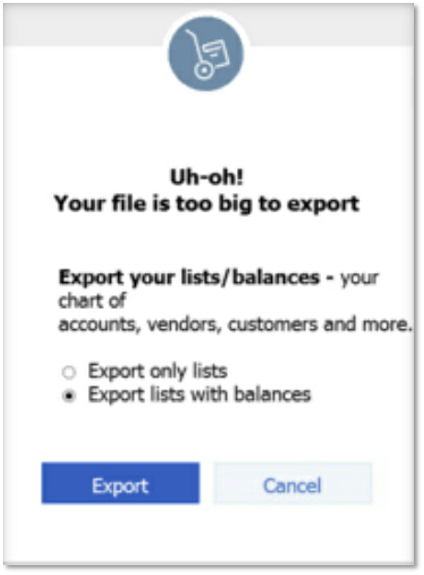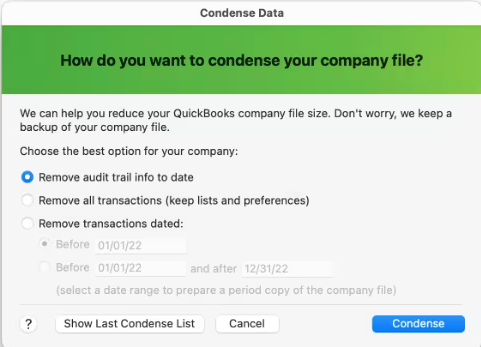Welcome to AskforAccounting company, a QuickBooks Service provider. We offer QuickBooks accounting services such as data conversion, data recovery, password recovery, rebuilding data, verification, error resolution, and many more. We’ve successfully helped clients with QuickBooks (Online and Desktop) over the last 5 years. In this blog, we’ll discuss the topic of QuickBooks condense data files.
QuickBooks data file condense is a critical function within QuickBooks accounting software. It allows users to reduce the size of their company files by removing unnecessary data, improving system performance, and making backups more manageable. This process condenses transaction details, optimizing the database while retaining essential information. Users can choose which data to condense, and the tool ensures the accuracy of financial reports after the operation. File condensing is especially valuable for businesses with large databases, as it helps maintain QuickBooks’ performance and usability. Regularly condensing company files is a best practice to ensure efficient accounting operations.
QuickBooks Condense Data File Strategies to Improve Performance
The QuickBooks condense data utility is a feature designed to streamline and optimize your QuickBooks company file. It allows you to reduce the file size by condensing and summarizing your data. This can be particularly helpful if your file has grown too large, affecting performance and responsiveness. The utility works by removing closed transactions and, in newer versions, even the audit trail while retaining essential details. The result is a more efficient and manageable file that not only saves storage space but also enhances the overall performance of your QuickBooks application.
Reasons for Condensing QuickBooks Data
Verify if condensing is the best choice for your company before doing it. It is advised that condense only after trying all other options because it cannot be undone.
- You have got a sizable data file.
- Your list needs to be longer.
- Your hardware has all been updated.
Benefits of Using Condense Data Utility
Using the condensed data utility in QuickBooks offers several advantages. This tool is especially beneficial for businesses dealing with large company files or sluggish performance. The key benefits of using the Condense Data Utility include.
- Improved Performance: Condensing your data file enhances the overall responsiveness and speed of your QuickBooks application. It reduces file size, making it more efficient.
- Network Stability: Smaller file sizes result in better network stability, ensuring that multiple users can access and work on QuickBooks simultaneously without interruptions.
- Reduced Data Corruption Risk: Condensing helps to maintain the integrity of your data by minimizing the chances of file corruption, ensuring your financial information remains secure.
- Easier Upgrades: Smaller files are easier to manage and upgrade to newer versions of QuickBooks 2024, saving time and effort during software updates.
- Enhanced Compatibility: The condensed data utility can improve compatibility with third-party applications, ensuring seamless integration with your business tools.
How to Use QuickBooks Condense Data File Utility
Using the condensed data utility in QuickBooks can lead to improved performance, stability, and data integrity, making it a valuable tool for businesses looking to optimize their financial management processes. Here’s how to use QuickBooks condense data file utility.
Method I- Find transactions that will not condense
In QuickBooks Desktop Premier and Enterprise Solutions, you can run a report to identify non-condensable transactions. This report provides links to these transactions for further action. To run the report, follow these steps:
- Go to the File menu, then select Utilities, and choose Condense Data.
- In the first window of the wizard, select “Transactions before a specific date” and enter the appropriate date.
- Check the box labeled “Optional: Create a report showing which transactions cannot be removed.”
- Select Next, and choose “Summarize inventory transactions” (recommended).
- Determine how your inventory will be condensed, and select Next.
- Choose the transaction groups you want to remove, and select Next.
- Click on “Begin Condense.”
Method II- Prepare your company file
Before condensing your data, you need to take the following preparatory steps.
- Remove the Closing Date from your data file, as you cannot condense data for periods after the closing date.
- To do this, go to the Edit menu, then select Preferences.
- Under Accounting, visit the Company Preferences tab, and choose “Set/Date Password” in the Closing Date area.
- Delete the date in the Closing Date box and select OK.
- Run the Profit and Loss and Balance Sheet (accrual basis, all dates, by year) reports to identify transactions entered before your company’s starting date. Ensure these transactions are correctly dated because they cannot be fixed after condensing.
- Re-sort your lists.
- Run the Rebuild and Verify Data utilities to identify and resolve any data damage.
- Create a copy of your company file and back it up in a secure location.
Method III- Save comparison reports
It’s essential to save comparison reports to verify the integrity of your data after condensing. These reports should be compared to the same reports you run after the condensing process. You can print or save the following reports for future use.
- Accrual-based Profit & Loss for all dates
- Accrual-based Balance Sheet for all dates
- Statement of Cash Flows
- A/R and A/P Aging Detail for all dates, as of the report date·
May be useful- QuickBooks Condense Data FailsCondense QuickBooks Desktop File for Import to QuickBooks Online
To condense your QuickBooks Desktop data for import into QuickBooks Online, follow these steps based on your QuickBooks version.

For QuickBooks Pro/Premier 2012 or Enterprise 12.0 and later
- Go to the QuickBooks File menu, select Utilities, and then Condense Data.
- When prompted about budget data, select “Yes” to continue.
- In the Condense Data window, choose “Transactions before a specific date.”
- Select a date, preferably the last day of the month if you track inventory then “Next.”
- Choose a method to summarize the transactions you’re removing, then click “Next.”
- Optionally, check any relevant checkboxes in the following dialog boxes, then click “Next.”
- Finally, select “Begin Condense.”
For QuickBooks Pro/Premier 2006 to 2011 or Enterprise Solutions 6.0 to 11.0
- From the QuickBooks File menu, select Utilities, and then Clean Up Company Data.
- Agree with the message about budget data.
- Select “Remove Transactions from a certain date.”
- Choose a date for removing closed transactions then “Next.”
- Optionally, select checkboxes under “Select Additional Criteria for Removing Transactions,” then click “Next.”
- Optionally, select checkboxes under “Select Unused List Items to Remove,” then click “Next.”
- Choose “Begin Cleanup” to start the process.
For QuickBooks for Mac
- Close all open QuickBooks windows.
- Go to the File menu, select Utilities, and then Condense Data.
- Choose a date (preferably the last day of the month if you track inventory).
- Confirm and proceed through the backup process.
- After condensing, you can prepare to move your QuickBooks Desktop data to QuickBooks Online (Windows or Mac).
These steps will help you condense your QuickBooks Desktop data for a smooth transition to QuickBooks Online.
Condense QuickBooks Desktop for MAC Company File
Learn how to utilize the Condense Data utility in QuickBooks Desktop for Mac to reduce your company file’s size. If your company file has become too large, you can condense it by selecting a smaller date range. QuickBooks will remove transactions falling outside this range and replace them with new summary transactions by month.
Using the Condense Data Utility
Select your QuickBooks version to condense your file. The Condense Data utility backs up your file before data removal, ensuring your original data can be restored in case of condense failure.
QuickBooks Mac Plus 2023
With QuickBooks Mac Plus 2023, you now have multiple options to reduce your company file’s size while retaining or removing specific data.

- Remove Audit Trail: This option removes the audit trail, reducing your file size but preserving detailed transactions.
- Go to File, select Utilities, then Condense Data.
- Choose Remove audit trail info to date then click Condense.
- Save a backup of your file.
- Review the info in the Condense Data Completed window.
Remove All Transactions
This choice eliminates all transactions while keeping list entries and preferences.
- Go to File, select Utilities, then Condense Data.
- Choose Remove all transactions (keep lists and preferences).
- Click Condense then save a backup of your file.
- Review the information in the Condense Data Completed window.
Remove Transactions Dated
This option removes transactions before a specific date and provides additional condensed operation choices.
- Go to File, select Utilities, then Condense Data.
- Choose Remove transactions dated.
- Select Before and choose a date.
- Select More Options and configure your preferred options. Assistance is available through Help.
- Save a backup of your file.
- Review the information in the Condense Data Completed window.
Period Copy
A period copy is a condensed file containing data for a specific period. Note that cash basis reports may not display correctly in the period copy.
- To create a period copy:
- Go to File, select Utilities, then Condense Data.
- Choose Remove transactions dated.
- Select before and after and pick dates.
- Select More Options and configure your preferred choices with Help available if needed.
- Save a backup of your file.
- Review the information displayed in the Condense Data Completed window.
Here are the options to choose when selecting “Remove transactions dated”:
- Transactions to remove.
- Transaction summarization preference.
- Inventory summarization preference.
- Removal of unused list entries.
QuickBooks Mac Plus 2022 and Earlier
- Go to the File menu and choose Utilities, then Condense Data.
- Specify the date from which you want to remove transactions then click OK.
- Confirm by clicking OK to create a backup file.
- Once the backup process is complete, click OK·
- Finally, click OK and review the information in Condense Data Completed.
If certain transactions couldn’t be removed, you’ll have the option to select “Show List” to examine those transactions, along with an explanation for why they were retained.
Conclusion
In conclusion, QuickBooks condense data file is a valuable feature for streamlining your financial data while maintaining software efficiency. By removing redundant and outdated information, it ensures accurate reporting and smoother performance. Regularly condensing your company files is a good practice. However, if you encounter any issues or have questions about this process, don’t hesitate to reach out to our QuickBooks experts for guidance and assistance in making the most of this tool. Your financial management needs are our priority.
Frequently Asked Questions
What is QuickBooks File Condense, and why is it necessary?
QuickBooks file condensing is a feature that helps reduce the size of your company file by removing unnecessary data. It’s essential to maintain optimal system performance and ensure efficient accounting operations.
How do I initiate the file condensing process in QuickBooks?
To condense your company file in QuickBooks, go to the “File” menu, select “Utilities,” and then choose “Condense Data.” Follow the on-screen instructions to customize the data you want to condense.
Can I choose which data to condense, or does QuickBooks decide for me?
You have the flexibility to select which data to condense. QuickBooks provides options for customizing the condensing process, allowing you to retain essential information.
Will condensing my company file affect the accuracy of my financial reports?
No, QuickBooks ensures that your financial reports remain accurate after the condensing process. It removes unnecessary transaction details while preserving vital data.
How often should I condense my QuickBooks company file?
The frequency of condensing your company file depends on its size and your accounting needs. It’s recommended to perform this task periodically, especially if your file is growing significantly.
Are there any precautions I should take before initiating the condensing process?
Before condensing, make sure to back up your company file. Additionally, review your data and ensure that all financial transactions are up-to-date and reconciled to avoid any issues during the condensing process.
What is data condensing, and how can it help reduce my QuickBooks file size?
Data condensing is the process of removing old transactions and summarizing data to create a smaller, more manageable QuickBooks file.

